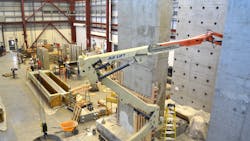Researchers to strengthen U.S. dams, levees with innovations
The University of Kansas (KU) announced that a team of researchers at the University of Kansas School of Engineering has partnered with U.S. federal agencies in a push to reinforce American dams and levees nationwide using fiber-reinforced polymers, sensors, artificial intelligence and drones.
The $7.7 million, five-year project is a partnership between The University of Kansas, the U.S. Army Engineer Research and Development Center (ERDC), the Department of Homeland Security’s Science and Technology Directorate and the U.S. Army Corps of Engineers.
"The project focuses on developing repairs and retrofits for the inventory of concrete dams in the U.S., with an emphasis on efficient damage detection,” said Caroline Bennett, heading work at KU. “In addition to repair methods, we’ll be using fiber-reinforced polymer materials, or FRPs, to address damage. Specifically, we’re targeting sliding at lift joints, restraining rocking between crest block and dam body during seismic loading, and damage on concrete spillways of dams. Our goal is to extend the usable lives of existing concrete dam infrastructure, which was mostly built in the 1930s and 1940s.”
Several of these New Deal-era dams have experienced catastrophic failures in recent years due to disrepair.
In 2005, New Orleans’ levees were breached with disastrous results during Hurricane Katrina, while levees in South Carolina were breached during Hurricane Matthew in 2016. A year later, relentless rain caused the Oroville Dam in California to fail. One recent assessment concluded the nation’s dams and levees need $93.6 billion in upgrades.
Before repairs are made, dams and levees must be assessed for repairs. KU researchers are developing new approaches for dam and levee damage-detection, which traditionally required people dangling from ropes. Their approach will rely on artificial intelligence, according to co-primary investigator Jian Li, who will lead much of that work.
“My main role is focused on using deep learning and computer vision to autonomously identify the location and severity of dam damage, such as concrete cracking and spalling, for which FRP repair is needed,” Li said. “Once the repair is done, these locations are no longer inspectable. Therefore, we’ll also develop self-sensing FRP repairs to enable continued monitoring of the repaired regions to ensure long-term safety. By leveraging emerging technologies including artificial intelligence, computer vision and advanced sensing, our research will greatly enhance timely repair, retrofit and maintenance of the nation’s large inventory of concrete dams.”
Rémy Lequesne, associate professor of civil, environmental & architectural engineering, will lead large-scale experimental testing of simulated joints in concrete dams, both with and without repairs.
“As America’s infrastructure ages, it’s important we become better at assessing whether structures can continue to serve safely and also develop improved methods to repair and extend the service-life of structures,” Lequesne said. “This project does just that. We’re developing more efficient methods for dam inspection and, through data collection and model development, providing tools that engineers can use to make decisions about whether and how to repair existing dams. Results will lead to recommendations and new modeling tools that engineers can use for assessment and design of repairs.”


